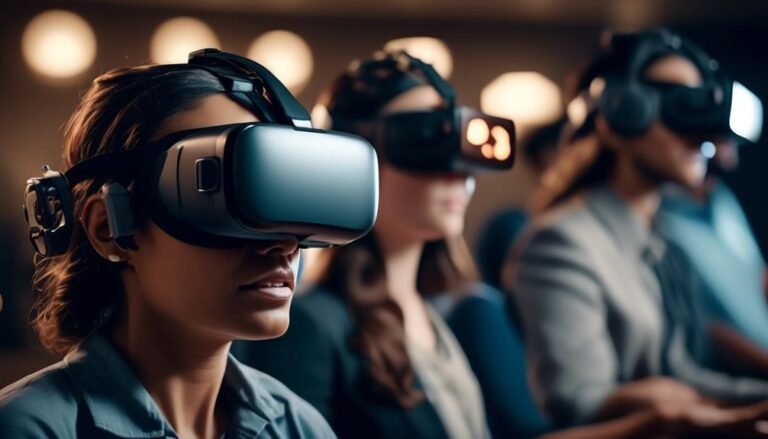5 Innovative Corporate Training Techniques Transforming Employee Development
In the fast-paced world of corporate training, organizations are constantly seeking new and innovative techniques to enhance employee development. As technology continues to evolve, so do the methods for imparting knowledge and skills to employees.
From virtual reality training to personalized adaptive learning, there are several groundbreaking approaches that are reshaping the landscape of corporate training. These techniques are not only revolutionizing how employees learn but also how they apply their knowledge in the workplace.
The impact of these innovative training methods on employee development is worth exploring further.
Key Takeaways
- Virtual Reality Training: Immersive simulations in VR provide a realistic and safe environment for employees to practice and improve their skills. This type of training is particularly beneficial for hands-on roles and allows for practical experience in a controlled setting. VR training is also valuable for upskilling and reskilling employees across industries.
- Gamification for Learning: Incorporating game-design elements in non-game contexts, such as training programs, can engage employees through competition, achievement, and reward. Gamification enhances problem-solving, decision-making, and critical thinking skills. It also improves employee engagement, information retention, and application of knowledge.
- Personalized Adaptive Learning: Tailoring educational experiences to individual needs, personalized adaptive learning delivers targeted learning materials and provides tailored feedback for improvement. Customized learning paths aligned with individual learning objectives enhance the learning experience and contribute to professional development.
- Microlearning Modules: Delivering brief and focused instructional units, microlearning modules are easily digestible and ideal for the fast-paced work environment. These modules are mobile-friendly, enabling employees to learn on-the-go. Adaptive assessments in microlearning provide personalized feedback and recommendations, maximizing productivity and learning opportunities.
Virtual Reality Training
Virtual Reality training has emerged as an innovative and effective method for enhancing corporate learning and development. By leveraging immersive simulations, Virtual Reality (VR) creates an interactive and realistic environment for employees to engage in experiential learning. This technology enables learners to participate in simulated scenarios that mimic real-world experiences, providing a safe space to practice and refine their skills.
Immersive simulations in VR allow employees to interact with lifelike situations, such as high-stress client interactions or complex problem-solving scenarios, in a controlled and supportive setting. This level of engagement can lead to deeper learning and better retention of information compared to traditional training methods. The interactive nature of VR simulations also promotes active participation, making the learning process more engaging and enjoyable for employees.
Additionally, VR training can be particularly beneficial for roles that require hands-on practice, such as technical maintenance or equipment operation. By immersing employees in realistic virtual environments, organizations can ensure that their workforce gains practical experience while minimizing the potential risks associated with on-the-job training. As a result, VR training proves to be a valuable tool for upskilling and reskilling employees across various industries.
Gamification for Learning
The evolution of corporate training techniques continues with the integration of gamification for learning, offering a dynamic approach to engage employees in skill development beyond traditional methods. Gamification involves the application of game-design elements and principles in non-game contexts, such as learning and development activities. It leverages the natural human inclination towards competition, achievement, and reward to make the learning process more engaging and enjoyable. One of the key aspects of gamification for learning is the incorporation of game-based assessment, where employees are evaluated through interactive and challenging scenarios, providing immediate feedback and fostering a continuous learning environment. By promoting learning through play, employees can enhance their problem-solving abilities, decision-making skills, and critical thinking in a more immersive and enjoyable manner. Incorporating gamification in corporate training not only enhances employee engagement but also leads to better retention of information and improved application of knowledge in real-world scenarios.
| Benefits of Gamification for Learning |
|---|
| Enhanced Employee Engagement |
| Improved Information Retention |
| Application of Knowledge in Real-World Scenarios |
Personalized Adaptive Learning
Personalized adaptive learning tailors educational experiences to individual needs, allowing for customized skill development and knowledge acquisition. This approach leverages technology to provide a personalized learning experience that adapts to the unique requirements of each employee.
Key features of personalized adaptive learning include:
- Adaptive assessment: Utilizing sophisticated algorithms, personalized adaptive learning systems assess the employee's current knowledge and skills. This enables the delivery of targeted learning materials and resources based on the individual's specific areas for improvement.
- Personalized coaching: Through personalized adaptive learning, employees receive tailored coaching and feedback to address their strengths and weaknesses. This personalized approach not only enhances the learning experience but also provides employees with actionable insights to improve their performance.
- Customized learning paths: Personalized adaptive learning platforms offer customized learning paths that align with the individual employee's learning objectives and career goals. This ensures that employees are engaged in relevant and meaningful learning experiences that contribute to their professional development.
Microlearning Modules
Utilizing brief and focused instructional units, microlearning modules provide employees with targeted and efficient learning experiences tailored to their specific skill development needs. These modules are designed to deliver content in small, easily digestible segments, making them ideal for today's fast-paced work environment.
Microlearning content is typically mobile-friendly, allowing employees to access training materials on-the-go, thereby maximizing their productivity and learning opportunities.
Additionally, these modules often incorporate adaptive assessments, which enable employees to receive personalized feedback and recommendations for further learning based on their individual performance.
Social Learning Platforms
Social learning platforms enable employees to engage in collaborative learning experiences, fostering knowledge sharing and skill development across the organization. These platforms leverage technology to create a dynamic and interactive space for learning and development, allowing employees to connect with peers, share insights, and access resources that enrich their professional growth.
Key elements of social learning platforms include:
- Peer to Peer Knowledge Sharing: These platforms facilitate the exchange of ideas, best practices, and experiences among employees, enabling them to learn from each other in a structured yet informal setting.
- Collaborative Learning: Employees can work together on projects, participate in group discussions, and contribute to collective knowledge, promoting a culture of teamwork and continuous learning.
- Community Engagement and User-Generated Content: Social learning platforms encourage community involvement and the creation of user-generated content, empowering employees to take ownership of their learning experience and contribute to the knowledge base of the organization.
Conclusion
In conclusion, it is clear that traditional training methods are being replaced by innovative techniques that are transforming employee development.
Virtual reality, gamification, personalized adaptive learning, microlearning modules, and social learning platforms are revolutionizing the way employees are trained.
These techniques are proving to be efficient and effective, despite initial skepticism.
It is ironic that as technology advances, the training methods become more human-centric, ultimately changing the landscape of corporate training.







